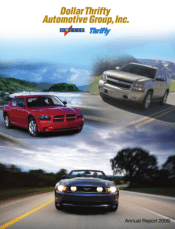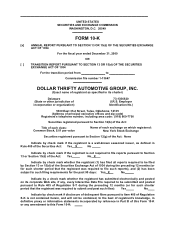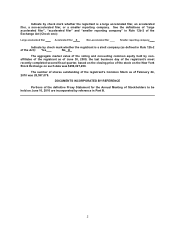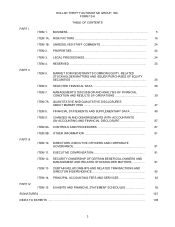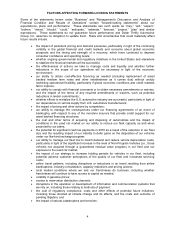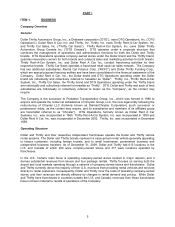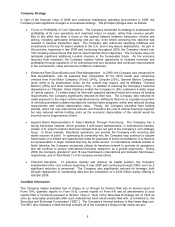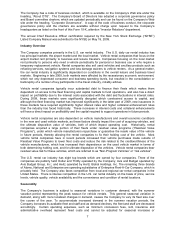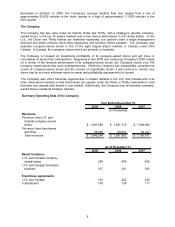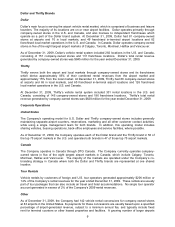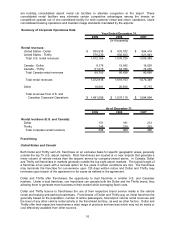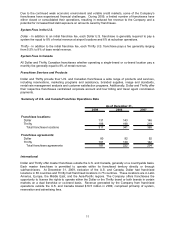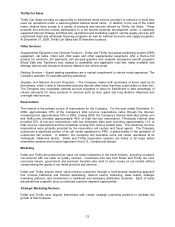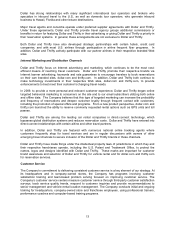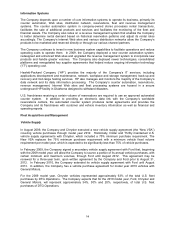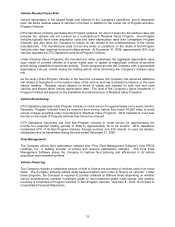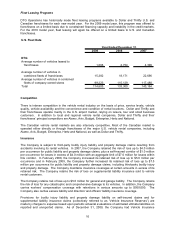Thrifty Car Rental 2009 Annual Report Download - page 7
Download and view the complete annual report
Please find page 7 of the 2009 Thrifty Car Rental annual report below. You can navigate through the pages in the report by either clicking on the pages listed below, or by using the keyword search tool below to find specific information within the annual report.Company Strategy
In light of the financial crisis of 2008 and continued challenging operating environment in 2009, the
Company made significant changes to its business strategy. The principal changes were as follows:
x Focus on Profitability of Core Operations. The Company reoriented its strategy to emphasize the
profitability of its core operations and maximize return on assets, rather than revenue growth.
Key to this effort has been a focus on the optimal balance between transaction volume and
pricing, including particularly enhancing rate per day, even where achieving this objective has
resulted in reduced transaction days. The Company also refocused operating initiatives and
investments to the top 75 airport markets in the U.S. and in key leisure destinations. As part of
this process, beginning in late 2008 and continuing throughout 2009, the Company closed over
100 company-owned stores that did not meet financial return objectives. The Company does not
anticipate significant additional location closures in the foreseeable future. As the economy
recovers from recession, the Company expects further opportunity to increase revenues and
profitability through expansion of its commercial and tour business and continued improvements
in the convenience, value and service it offers to customers.
x Enhanced Fleet Diversification and Fleet Management. In 2009, the Company also enhanced its
fleet diversification, with its expected fleet composition for the 2010 model year comprising
vehicles from Ford Motor Company (“Ford”) (34%), Chrysler (30%), General Motors Company
(such entity or its predecessor entity, as the context may require, and its affiliates, “General
Motors”) (20%) and other manufacturers (16%). In addition to reducing the Company’s historical
dependence on Chrysler, these initiatives enable the Company to offer customers a wider range
of vehicle options. To better match its fleet with expected demand levels and reduce its funding
requirements, the Company significantly reduced its fleet size. The Company also reduced its
credit exposure to the major vehicle manufacturers by shifting its fleet mix to a greater proportion
of vehicles purchased outside manufacturer residual value programs, which also reduced funding
requirements and vehicle depreciation rates. Finally, the Company extended fleet holding
periods, which not only reduced the amount, and therefore the cost of vehicle financing required,
but also reduced vehicle holding costs as the economic depreciation of the vehicle would be
incurred over a longer period of time.
x Expand Brand Representation in Select Markets Through Franchising. The Company has a
strong franchisee network, which provides it with brand representation in international markets,
smaller U.S. airport locations and local markets that are not part of the Company’s core strategic
focus. In those markets, franchised operations can provide the Company with recurring and
stable sources of profit. In optimizing its ownership mix, the Company may continue to acquire
franchisees on a limited and opportunistic basis for purposes of brand consolidation or to improve
its representation in larger markets that may be under-served. In international markets outside of
North America, the Company exclusively utilizes its franchise network to promote its operations,
and will continue to pursue international franchise expansion as a growth opportunity. During
2009, the Company granted 21 and 18 new franchises to international and domestic franchisees,
respectively, and re-franchised 11 of its company-owned stores.
x Financial Discipline. To preserve liquidity and improve its capital position, the Company
implemented strict cost controls beginning in late 2008 and continuing through 2009, such as a
significant reduction in personnel. The Company also significantly reduced its leverage, both
through repayments of outstanding debt and the completion of a $120 million equity offering in
October 2009.
Available Information
The Company makes available free of charge on or through its Internet Web site its annual report on
Form 10-K, quarterly reports on Form 10-Q, current reports on Form 8-K and all amendments to such
reports filed or furnished pursuant to Section 13(a) or 15(d) of the Securities Exchange Act of 1934 as
soon as reasonably practicable after such material has been electronically filed with, or furnished to, the
Securities and Exchange Commission (“SEC”). The Company’s Internet address is http://www.dtag.com.
The SEC also maintains a Web site that contains all of the Company’s filings at http://www.sec.gov.
6

